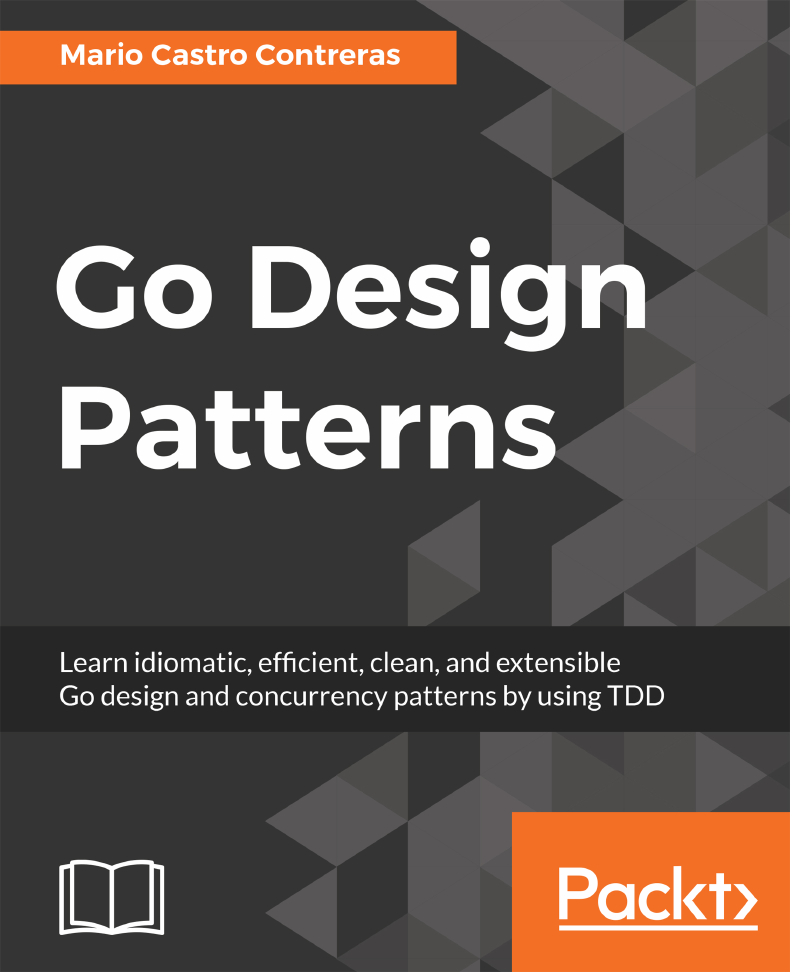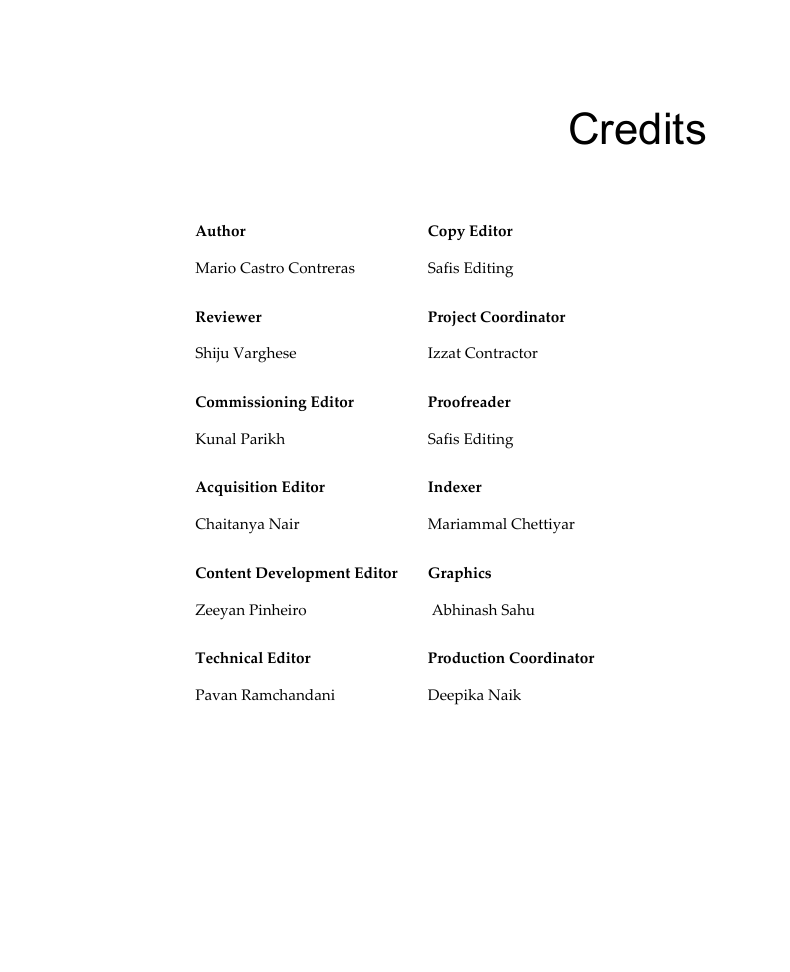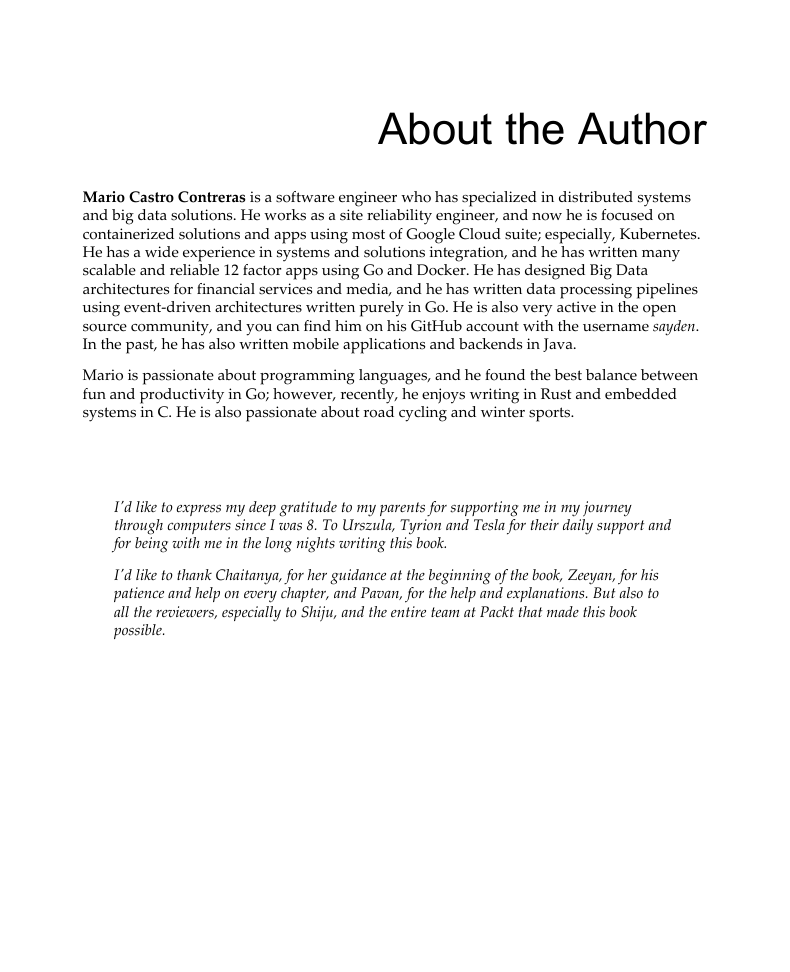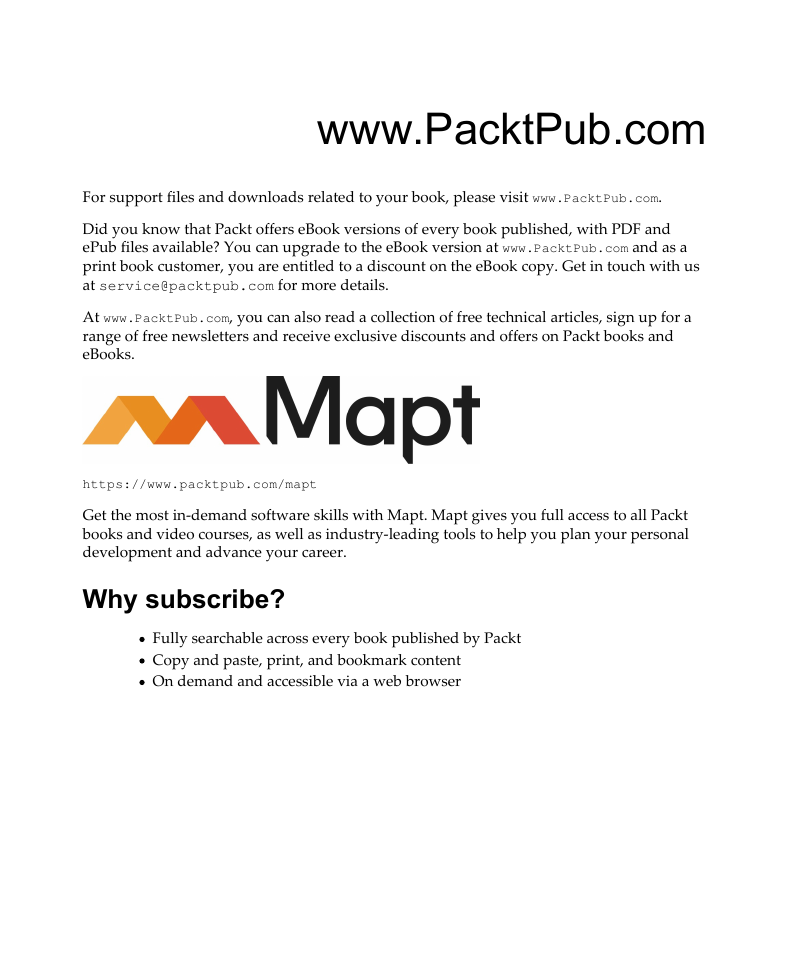Cover
Copyright
About the Author
Table of Contents
Preface
1: Ready... Steady... Go!
A little bit of history
Installing Go
Linux
Go Linux advanced installation
Windows
Mac OS X
Setting the workspace – Linux and Apple OS X
Starting with Hello World
Integrated Development Environment – IDE
Types
Variables and constants
Operators
Flow control
The if… else statement
The switch statement
The for…range statement
Functions
What does a function look like?
What is an anonymous function?
Closures
Creating errors, handling errors and returning errors.
Function with undetermined number of parameters
Naming returned types
Arrays, slices, and maps
Arrays
Zero-initialization
Slices
Maps
Visibility
Zero-initialization
Pointers and structures
What is a pointer? Why are they good?
Structs
Interfaces
Interfaces – signing a contract
Testing and TDD
The testing package
What is TDD?
Libraries
The Go get tool
Managing JSON data
The encoding package
Go tools
The golint tool
The gofmt tool
The godoc tool
The goimport tool
Contributing to Go open source projects in GitHub
Summary
2: Creational Patterns -Singleton, Builder, Factory, Prototype, and Abstract Factory Design Patterns
Singleton design pattern – having a unique instance of a type in the entire program
Description
Objectives
Example – a unique counter
Requirements and acceptance criteria
Writing unit tests first
Implementation
A few words about the Singleton design pattern
Builder design pattern – reusing an algorithm to create many implementations of an interface
Description
Objectives
Example – vehicle manufacturing
Requirements and acceptance criteria
Unit test for the vehicle builder
Implementation
Wrapping up the Builder design pattern
Factory method – delegating the creation of different types of payments
Description
Objectives
The example – a factory of payment methods for a shop
Acceptance criteria
First unit test
Implementation
Upgrading the Debitcard method to a new platform
What we learned about the Factory method
Abstract Factory – a factory of factories
Description
The objectives
The vehicle factory example, again?
Acceptance criteria
Unit test
Implementation
A few lines about the Abstract Factory method
Prototype design pattern
Description
Objective
Example
Acceptance criteria
Unit test
Implementation
What we learned about the Prototype design pattern
Summary
3: Structural Patterns - Composite, Adapter, and Bridge Design Patterns
Composite design pattern
Description
Objectives
The swimmer and the fish
Requirements and acceptance criteria
Creating compositions
Binary Tree compositions
Composite pattern versus inheritance
Final words on the Composite pattern
Adapter design pattern
Description
Objectives
Using an incompatible interface with an Adapter object
Requirements and acceptance criteria
Unit testing our Printer adapter
Implementation
Examples of the Adapter pattern in Go's source code
What the Go source code tells us about the Adapter pattern
Bridge design pattern
Description
Objectives
Two printers and two ways of printing for each
Requirements and acceptance criteria
Unit testing the Bridge pattern
Implementation
Reuse everything with the Bridge pattern
Summary
4: Structural Patterns - Proxy, Facade, Decorator, and Flyweight Design Patterns
Proxy design pattern
Description
Objectives
Example
Acceptance criteria
Unit test
Implementation
Proxying around actions
Decorator design pattern
Description
Objectives
Example
Acceptance criteria
Unit test
Implementation
A real-life example – server middleware
Starting with the common interface, http.Handler
A few words about Go's structural typing
Summarizing the Decorator design pattern – Proxy versus Decorator
Facade design pattern
Description
Objectives
Example
Acceptance criteria
Unit test
Implementation
Library created with the Facade pattern
Flyweight design pattern
Description
Objectives
Example
Acceptance criteria
Basic structs and tests
Implementation
What's the difference between Singleton and Flyweight then?
Summary
5: Behavioral Patterns - Strategy, Chain of Responsibility, and Command Design Patterns
Strategy design pattern
Description
Objectives
Rendering images or text
Acceptance criteria
Implementation
Solving small issues in our library
Final words on the Strategy pattern
Chain of responsibility design pattern
Description
Objectives
A multi-logger chain
Unit test
Implementation
What about a closure?
Putting it together
Command design pattern
Description
Objectives
A simple queue
Acceptance criteria
Implementation
More examples
Chain of responsibility of commands
Rounding-up the Command pattern up
Summary
6: Behavioral Patterns - Template, Memento, and Interpreter Design Patterns
Template design pattern
Description
Objectives
Example – a simple algorithm with a deferred step
Requirements and acceptance criteria
Unit tests for the simple algorithm
Implementing the Template pattern
Anonymous functions
How to avoid modifications on the interface
Looking for the Template pattern in Go's source code
Summarizing the Template design pattern
Memento design pattern
Description
Objectives
A simple example with strings
Requirements and acceptance criteria
Unit test
Implementing the Memento pattern
Another example using the Command and Facade patterns
Last words on the Memento pattern
Interpreter design pattern
Description
Objectives
Example – a polish notation calculator
Acceptance criteria for the calculator
Unit test of some operations
Implementation
Complexity with the Interpreter design pattern
Interpreter pattern again – now using interfaces
The power of the Interpreter pattern
Summary
7: Behavioral Patterns - Visitor, State, Mediator, and Observer Design Patterns
Visitor design pattern
Description
Objectives
A log appender
Acceptance criteria
Unit tests
Implementation of Visitor pattern
Another example
Visitors to the rescue!
State design pattern
Description
Objectives
A small guess the number game
Acceptance criteria
Implementation of State pattern
A state to win and a state to lose
The game built using the State pattern
Mediator design pattern
Description
Objectives
A calculator
Acceptance criteria
Implementation
Uncoupling two types with the Mediator
Observer design pattern
Description
Objectives
The notifier
Acceptance criteria
Unit tests
Implementation
Summary
8: Introduction to Gos Concurrency
A little bit of history and theory
Concurrency versus parallelism
CSP versus actor-based concurrency
Goroutines
Our first Goroutine
Anonymous functions launched as new Goroutines
WaitGroups
Callbacks
Callback hell
Mutexes
An example with mutexes – concurrent counter
Presenting the race detector
Channels
Our first channel
Buffered channels
Directional channels
The select statement
Ranging over channels too!
Using it all – concurrent singleton
Unit test
Implementation
Summary
9: Concurrency Patterns - Barrier, Future, and Pipeline Design Patterns
Barrier concurrency pattern
Description
Objectives
An HTTP GET aggregator
Acceptance criteria
Unit test – integration
Implementation
Waiting for responses with the Barrier design pattern
Future design pattern
Description
Objectives
A simple asynchronous requester
Acceptance criteria
Unit tests
Implementation
Putting the Future together
Pipeline design pattern
Description
Objectives
A concurrent multi-operation
Acceptance criteria
Beginning with tests
Implementation
The list generator
Raising numbers to the power of 2
Final reduce operation
Launching the Pipeline pattern
Final words on the Pipeline pattern
Summary
10: Concurrency Patterns - Workers Pool and Publish/Subscriber Design Patterns
Workers pool
Description
Objectives
A pool of pipelines
Acceptance criteria
Implementation
The dispatcher
The pipeline
An app using the workers pool
No tests?
Wrapping up the Worker pool
Concurrent Publish/Subscriber design pattern
Description
Objectives
Example – a concurrent notifier
Acceptance criteria
Unit test
Testing subscriber
Testing publisher
Implementation
Implementing the publisher
Handling channels without race conditions
A few words on the concurrent Observer pattern
Summary
Index
















 2023年江西萍乡中考道德与法治真题及答案.doc
2023年江西萍乡中考道德与法治真题及答案.doc 2012年重庆南川中考生物真题及答案.doc
2012年重庆南川中考生物真题及答案.doc 2013年江西师范大学地理学综合及文艺理论基础考研真题.doc
2013年江西师范大学地理学综合及文艺理论基础考研真题.doc 2020年四川甘孜小升初语文真题及答案I卷.doc
2020年四川甘孜小升初语文真题及答案I卷.doc 2020年注册岩土工程师专业基础考试真题及答案.doc
2020年注册岩土工程师专业基础考试真题及答案.doc 2023-2024学年福建省厦门市九年级上学期数学月考试题及答案.doc
2023-2024学年福建省厦门市九年级上学期数学月考试题及答案.doc 2021-2022学年辽宁省沈阳市大东区九年级上学期语文期末试题及答案.doc
2021-2022学年辽宁省沈阳市大东区九年级上学期语文期末试题及答案.doc 2022-2023学年北京东城区初三第一学期物理期末试卷及答案.doc
2022-2023学年北京东城区初三第一学期物理期末试卷及答案.doc 2018上半年江西教师资格初中地理学科知识与教学能力真题及答案.doc
2018上半年江西教师资格初中地理学科知识与教学能力真题及答案.doc 2012年河北国家公务员申论考试真题及答案-省级.doc
2012年河北国家公务员申论考试真题及答案-省级.doc 2020-2021学年江苏省扬州市江都区邵樊片九年级上学期数学第一次质量检测试题及答案.doc
2020-2021学年江苏省扬州市江都区邵樊片九年级上学期数学第一次质量检测试题及答案.doc 2022下半年黑龙江教师资格证中学综合素质真题及答案.doc
2022下半年黑龙江教师资格证中学综合素质真题及答案.doc